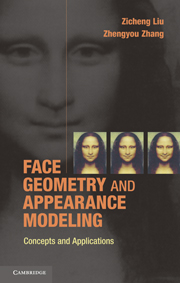3 - Appearance models
from PART I - FACE REPRESENTATIONS
Published online by Cambridge University Press: 01 June 2011
Summary
The appearance of an object depends not only on its geometry but also the lighting environment and its reflectance property. Such relationships are characterized by illumination models. In computer graphics, people have developed various illumination models for image synthesis. Some of the illumination models are very useful for face geometry and appearance modeling. In this chapter, we will first give a brief overview on the illumination models. We then describe subspace representations of diffuse lighting and face albedos, which are useful tools for the recovery of face geometry, albedo, and lighting.
Illumination models
Bidirectional reflectance distribution function
For any point on an surface, its reflectance property can be categorized by a four-dimensional function ρ(L, V), where L is the incoming light direction and V is the reflected light direction (see Figure 3.1). ρ(L, V) is called a Bidirectional Reflectance Distribution Function (BRDF). We usually represent L with its spherical angles θi, and ϕi, and V with θr and ϕr. Thus, ρ can be written as a function of the four angles as ρ(θi, ϕi, θr, ϕr). Strictly speaking, we have a different BRDF for each wavelength. In practice, we usually use a BRDF for each (R, G, B) color channel.
- Type
- Chapter
- Information
- Face Geometry and Appearance ModelingConcepts and Applications, pp. 31 - 40Publisher: Cambridge University PressPrint publication year: 2011



